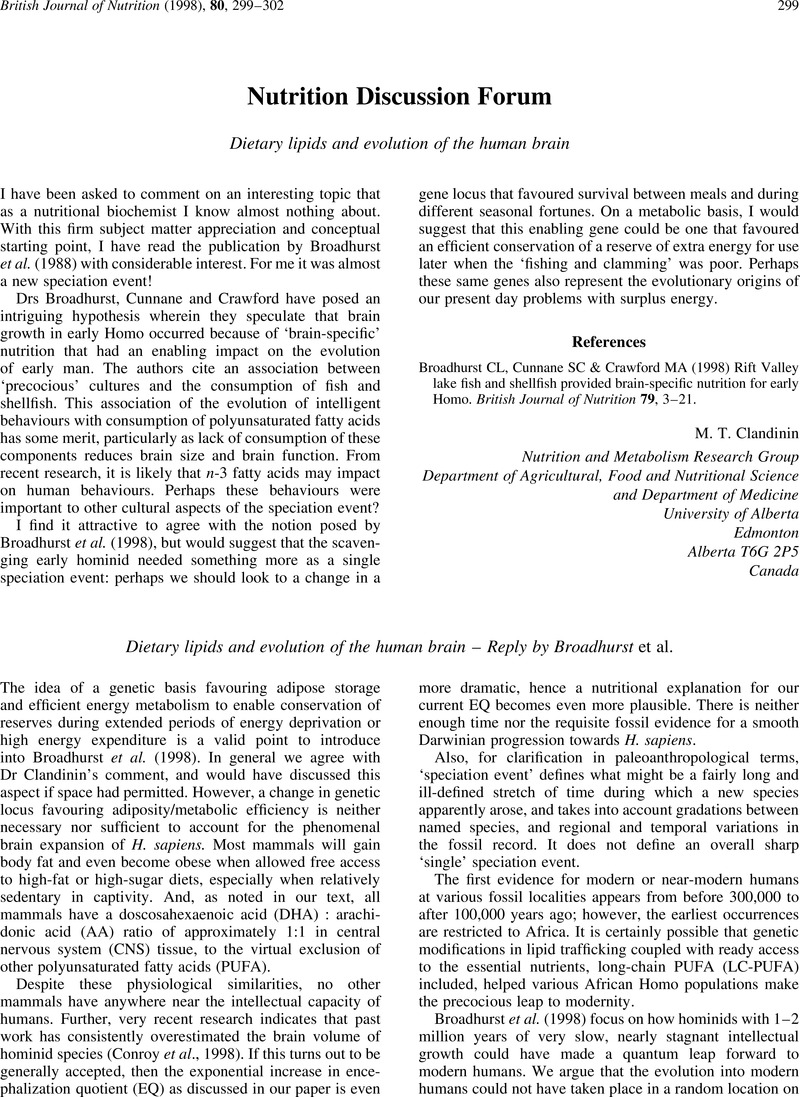No CrossRef data available.
Article contents
Nutrition Discussion Forum
Published online by Cambridge University Press: 09 March 2007
Abstract
An abstract is not available for this content so a preview has been provided. As you have access to this content, a full PDF is available via the ‘Save PDF’ action button.

- Type
- Nutrition Discussion Forum
- Information
- Copyright
- Copyright © The Nutrition Society 1998
References
Broadhurst, CL, Cunnane, SC & Crawford, MA (1998) Rift Valley lake fish and shellfish provided brain-specific nutrition for early Homo. British Journal of Nutrition 79, 3–21.CrossRefGoogle ScholarPubMed
Broadhurst, CL (1997) Nutrition and non-insulin dependent diabetes mellitus from an anthropological perspective. Alternative Medicine Review 2, 378–399.Google Scholar
Broadhurst, CL, Cunnane, SC & Crawford, MC (1998) Rift Valley lake fish and shellfish provided brain-specific nutrition for early Homo. British Journal of Nutrition 79, 3–21.CrossRefGoogle ScholarPubMed
Carter, JS, Pugh, JA & Monterrosa, A (1996) Non-insulin dependent diabetes mellitus in minorities in the United States. Annals of Internal Medicine 125, 221–232.CrossRefGoogle ScholarPubMed
Chen, Z-Y, Menard, CR & Cunnane, SC (1995) Moderate selective depletion of linoleate and α-linoleate in weight-cycled rats. American Journal of Physiology 268, R498–R505.Google Scholar
Conroy, GC, Weber, GW, Seidler, H, Tobias, PV, Kane, A & Brunsden, B (1998) Endocranial capacity in an early hominid cranium from Sterkfontain, South Africa. Science 280, 1730–1731.CrossRefGoogle Scholar
Crawford, MA, Kirby, E & Morgan, E [Editors] (1993) The aquatic ape: selected papers. Nutrition and Health 9, 157–235.CrossRefGoogle Scholar
Cunnane, SC & Anderson, MJ (1997) The majority of dietary linoleate in growing rats is β-oxidized or stored in visceral fat. Journal of Nutrition 127, 146–152.CrossRefGoogle ScholarPubMed
Kissebah, AH & Hennes, MMI (1995) Central obesity and free fatty acid metabolism. Prostaglandins Leukotrienes and Essential Fatty Acids 52, 209–211.CrossRefGoogle ScholarPubMed
Neel, JV (1962) Diabetes mellitus: a “thrifty” genotype rendered detrimental by “progress”. American Journal of Human Genetics 14, 353–362.Google ScholarPubMed
Ravussin, E & Bogardus, C (1990) Energy expenditure in the obese: is there a thrifty gene? Infusionstherapie 76, 108–112.CrossRefGoogle Scholar
Szathmary, EJE (1994) Non-insulin dependent diabetes mellitus among aboriginal North Americans. Annual Reviews of Anthropology 23, 457–482.CrossRefGoogle Scholar
Broadhurst, CL, Cunnane, SC & Crawford, MA (1998) Rift Valley lake fish and shellfish provided brain-specific nutrition for early Homo. British Journal of Nutrition 79, 3–21.CrossRefGoogle ScholarPubMed
Chamberlain, JG (1994 a) Long-chain polyunsaturated fatty acids in human brain evolution. FASEB Journal 8, A736.Google Scholar
Chamberlain, JG (1994 b) Possible role of long-chain polyunsaturated fatty acids in human brain evolution. Proceedings of AAAS Meeting, San Francisco, CA. Abstr.Google Scholar
Chamberlain, JG (1996) The possible role of long-chain, omega-3 fatty acids in human brain phylogeny. Perspectives in Biology and Medicine 39, 436–445.CrossRefGoogle ScholarPubMed
Chamberlain, JG (1997) On diet quality and humanoid brain/digestive system evolution (letter). Current Anthropology 38, 91.CrossRefGoogle Scholar
Aiello, LC & Wheeler, P (1995) The expensive tissue hypothesis. The brain and digestive system in human and primate evolution. Current Anthropology 36, 199–221.CrossRefGoogle Scholar
Broadhurst, CL, Cunnane, SC & Crawford, MA (1998) Rift Valley lake fish and shellfish provided brain specific nutrition for early Homo. British Journal of Nutrition 79, 3–21.CrossRefGoogle ScholarPubMed
Chamberlain, JG (1996) The possible role of long-chain, omega-3 fatty acids in human brain phylogeny. Perspectives in Biology and Medicine 39, 436–445.CrossRefGoogle ScholarPubMed
Chamberlain, JG (1997) On diet quality and humanoid brain/digestive system evolution (letter). Current Anthropology 38, 91.CrossRefGoogle Scholar


